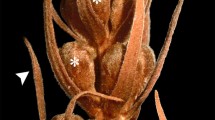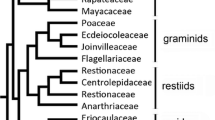Abstract
We present a comparative study of the floral structure and development of Nartheciaceae, a small dioscorealean family consisting of five genera (Aletris, Lophiola, Metanarthecium, Narthecium, and Nietneria). A noticeable diversity existed in nine floral characters. Analyses of their respective character states in the light of a phylogenetic context revealed that the flowers of Nartheciaceae, whose plesiomorphies occur in Aletris and Metanarthecium, have evolved toward in all or part of Lophiola, Narthecium, and Nietneria: (1) loss of a perianth tube; (2) stamen insertion at the perianth base; (3) congenital carpel fusion; (4) loss of the septal nectaries; (5) unilocular style; (6) unfused lateral carpellary margins in the style; (7) flower with the median outer tepal on the abaxial side; (8) flower with moniliform hairs; and (9) flower with weak monosymmetry. We further found that, as the flowers developed, the ovary shifted its position from inferior to superior. As a whole, their structure changes suggest that the Nartheciaceae flowers have evolved in close association with pollination and seed dispersal. By considering inferior ovaries and the presence of septal nectaries as plesiomorphies of Nartheciaceae, we discussed evolution of the ovary position and septal nectaries in all the monocots.











Similar content being viewed by others
References
APG (Angiosperm Phylogeny Group) IV (2016) An update of the Angiosperm Phylogeny Group classification for the orders and families of flowering plants: APG IV. Bot J Linn Soc 181:1–20
Bayer E (1998) Alstroemeriaceae. In: Kubitzki K (ed) The families and genera of vascular plants. vol III, Flowering plants Monocotyledons Lilianae (except Orchidaceae). Springer, Berlin, pp 79–83
Caddick LR, Wilkin P, Rudall PJ, Hedderson TAJ, Chase MW (2002) Yams reclassified: a recircumsciption of Dioscoreaceae and Dioscoreales. Taxon 51:103–114
Chase MW, Soltis DE, Soltis PS, Rudall PJ, Fay MF, Hahn WH, Sullivan S, Joseph J, Molvray M, Kores PJ, Givnish TJ, Sytsma KJ, Pires JC (2000) Higher-level systematics of the monocotyledons: an assessment of current knowledge and a new classification. In: Wilson KL, Morrison DA (eds) Monocots: systematics and evolution. CSIRO, Collingwood, pp 3–16
Dahlgren RMT, Clifford HT, Yeo PF (1985) The families of the monocotyledons. Springer, Berlin
Davis JI, Petersen G, Seberg O, Stevenson DW, Hardy CR, Simmons MP, Michelangeli FA, Goldman DH, Campbell LM, Specht CD, Cohen JI (2006) Are mitochondrial genes useful for the analysis of monocot relationships? Taxon 55:857–870
Duvall MR, Learn GH Jr, Eguiarte LE, Clegg MT (1993) Phylogenetic analysis of rbcL sequences identifies Acorus calamus as the primal extant monocotyledon. Proc National Acad Sci 90:4611–4614
Endress P (1995) Major evolutionary traits of monocot flowers. In: Rudall PJ, Cribb PJ, Cutler DF, Humphries CJ (eds) Monocotyledons: systemaics and evolution. Royal Botanic Garden, Kew, pp 43–79
Endress P (2011) Evolutionary diversification of the flowers in angiosperms. Am J Bot 98:370–396
Fuse S, Tamura MN (2000) A phylogenetic analysis of the plastid matK gene with emphasis on Melanthiaceae sensu lato. Plant Biol 2:415–427
Fuse S, Lee NS, Tamura MN (2012) Biosystematic studies on the family Nartheciaceae (Dioscoreales) I. Phylogenetic relationships, character evolution and taxonomic re-examination. Plant Syst Evol 298:15751584
Goldblatt P, Manning JC, Rudall P (1998) Iridaceae. In: Kubitzki K (ed) The families and genera of vascular plants, vol III, Flowering plants Monocotyledons Lilianae (except Orchidaceae). Springer, Berlin, pp 295–333
Hara H (1967) The status of the genus Metanarthecium Maxim. J Jap Bot 42:312–316
Heel WA van (1988) On the development of some gynoecia with septal nectaries. Blumea 33:477–504
Hertweck KL, Kinney MS, Stuart SA, Maurin O, Mathews S, Chase MW, Gandolfo MA, Pires JC (2015) Phylogenetics, divergence times and diversification from three genomic partitions in monocots. Bot J Linn Soc 178:375–393
Ishii HS, Sakai S (2001) Effects of display size and position on individual floral longevity in racemes of Narthecium asiaticum (Liliaceae). Funct Ecol 15:396–405
Leinfellner W (1950) Der Bauplan des synkarpen Gynözeums. Oesterr Bot Z 97:403–436
Maddison WP, Maddison DR (2015) Mesquite: a modular system for evolutionary analysis. Version 3.03 http://mesquiteproject.org. Accessed 22 Sept 2017
Maximowicz CJ (1867) Diagnosos breves plantarum novarum Japoniae et Mandshuriae. Bull Acad Imp Sci St-Petersburg 11:434–439
Melchior H (1964) Reihe Liliiflorae (Liliales). In: Melchior H (ed) A. Engler’s Syllabus der Pflanzenfamilien II. Gebrüder Borntraeger, Berlin, pp 513–543
Merckx V, Schols V, Maas-van de Kamer H, Maas P, Huysmans S, Smets EF (2006) Phylogeny and evolution of Burmanniaceae (Dioscoreales) based on nuclear and mitochondrial data. Amer J Bot 93:1684–1698
Merckx V, Schols P, Geuten K, Huysmans S, Smets E (2008) Phylogenetic relationships in Nartheciaceae (Dioscoreales), with focus on pollen and orbicule morphology. Belgian J Bot 141:64–77
Petersen G, Seberg O, Cuenca A, Stevenson DW, Thadeo M, Davis JI, Graham S, Ross TG (2015) Phylogeny of the Alismatales (monocotyledons) and the relationship of Acorus (Acorales?). Cladistics 32:141–159
Remizowa M, Sokoloff D, Rudall PJ (2006) Evolution of the monocot gynoecium: evidence from comparative morphology and development in Tofieldia, Japonolirion, Petrosavia and Narthecium. Plant Sys Evol 258:183–209
Remizowa M, Sokoloff D, Kondo K (2008) Floral evolution in the monocot family Nartheciaceae (Dioscoreales): evidence from anatomy and development in Metanarthecium luteo-viride Maxim. Bot J Linn Soc 158:1–18
Remizowa M, Sokoloff DD, Rudall PJ (2010) Evolutionary history of the monocot flower. Ann Missouri Bot Gard 97:617–645
Rudall P (2002) Homologies of inferior ovaries and septal nectarines in monocotyledons. Int J Plant Sci 163:261–276
Simpson MG (1998) Reversal in ovary position from inferior to superior in the Haemodoraceae: evidence from floral ontogeny. Int J Plant Sci 159:466–479
Simpson MG, Dickison WC (1981) Comparative anatomy of Lachnanthes and Lophiola (Haemodoraceae). Flora 171:95–113
Smets EF, Ronse-Decraene L-P, Caris P, Rudall PJ (2000) Floral nectaries in monocotyledons: distribution and evolution. In: Wilson KL, Morrison DA (eds) Monocots: systematic and evolution. Commonwealth Scientific and Industrial Research Organization, Melbourne, pp 230–240
Soltis DF, Soltis PS, Endress PK, Chase MW (2006) Phylogeny and evolution of angiosperms. Sinauer Assoc. Inc., Sunderland
Soltis DE, Gitzendanner MA, Soltis PS (2007) A 567-taxon data set for angiosperms: The challenges posed by Bayesian analyses of large data sets. Int J Plant Sci 168:137–157
Sterling C (1979) Comparative morphology of the carpel in the Liliaceae: Tofieldieae. Bot J Linn Soc 79:321–332
Stevens PF (2001 onwards) Angiosperm Phylogeny Web site, version 14. July 2017 [and more or less continuously updated since]. Web site http://www.mobot.org/MOBOT/research/APweb/. Accessed 26 Nov 2017
Stevenson DW, Davis JI, Freudenstein JV, Hardy CR, Simmons MP, Specht CD (2000) A phylogenetic analysis of the monocotyledons based on morphological and molecular character sets, with comments on the placement of Acorus and Hydatellaceae. In: Wilson KL, Morrison DA (eds) Monocots: systematics and evolution. CSIRO, Collingwood, pp 17–32
Takhtajan A (2009) Flowering plants, 2nd edn. Springer, New York
Tamura MN (1998) Nartheciaceae. In: Kubitzki K (ed) The families and genera of vascular plants III. Springer, Berlin, pp 391–392
Thorne RF (1992) Classification and geography of flowering plants. Bot Rev 58:225–348
Tobe H (2012) Floral structure of Cardiopteris (Cardiopteridaceae) with special emphasis on the gynoecium: systematic and evolutionary implications. J Plant Res 125:361–369
Utech FH (1978) Floral vascular anatomy of the monotypic Japanese Metanarthecium luteoviride Maxim. (Liliaceae–Melanthioideae). Ann Carnegie Mus Nat Hist 47:455–477
Zomlefer WB (1999) Advances in angiosperm systematics: examples from the Liliales and Asparagales. J Torrey Bot Soc 126:58–62
Acknowledgements
The study was supported by a Grant-in-Aid for Scientific Research from the Japan Society for the Promotion of Science (No. 16H05763, 17K07530).
Author information
Authors and Affiliations
Corresponding author
Rights and permissions
About this article
Cite this article
Tobe, H., Huang, YL., Kadokawa, T. et al. Floral structure and development in Nartheciaceae (Dioscoreales), with special reference to ovary position and septal nectaries. J Plant Res 131, 411–428 (2018). https://doi.org/10.1007/s10265-018-1026-9
Received:
Accepted:
Published:
Issue Date:
DOI: https://doi.org/10.1007/s10265-018-1026-9




